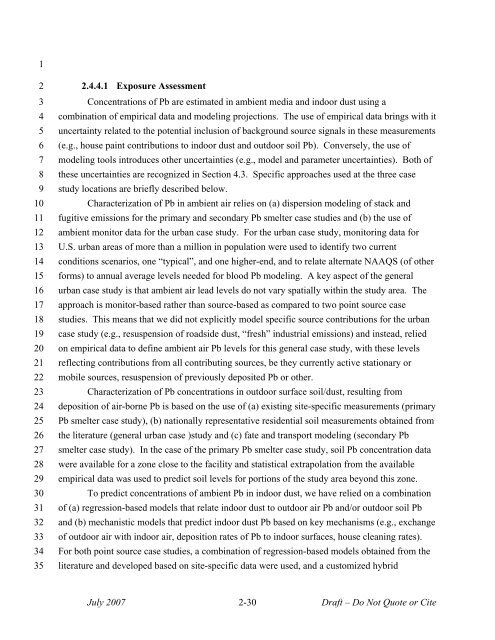Lead Human Exposure and Health Risk Assessments for Selected ...
Lead Human Exposure and Health Risk Assessments for Selected ...
Lead Human Exposure and Health Risk Assessments for Selected ...
You also want an ePaper? Increase the reach of your titles
YUMPU automatically turns print PDFs into web optimized ePapers that Google loves.
1<br />
2<br />
3<br />
4<br />
5<br />
6<br />
7<br />
8<br />
9<br />
10<br />
11<br />
12<br />
13<br />
14<br />
15<br />
16<br />
17<br />
18<br />
19<br />
20<br />
21<br />
22<br />
23<br />
24<br />
25<br />
26<br />
27<br />
28<br />
29<br />
30<br />
31<br />
32<br />
33<br />
34<br />
35<br />
2.4.4.1 <strong>Exposure</strong> Assessment<br />
Concentrations of Pb are estimated in ambient media <strong>and</strong> indoor dust using a<br />
combination of empirical data <strong>and</strong> modeling projections. The use of empirical data brings with it<br />
uncertainty related to the potential inclusion of background source signals in these measurements<br />
(e.g., house paint contributions to indoor dust <strong>and</strong> outdoor soil Pb). Conversely, the use of<br />
modeling tools introduces other uncertainties (e.g., model <strong>and</strong> parameter uncertainties). Both of<br />
these uncertainties are recognized in Section 4.3. Specific approaches used at the three case<br />
study locations are briefly described below.<br />
Characterization of Pb in ambient air relies on (a) dispersion modeling of stack <strong>and</strong><br />
fugitive emissions <strong>for</strong> the primary <strong>and</strong> secondary Pb smelter case studies <strong>and</strong> (b) the use of<br />
ambient monitor data <strong>for</strong> the urban case study. For the urban case study, monitoring data <strong>for</strong><br />
U.S. urban areas of more than a million in population were used to identify two current<br />
conditions scenarios, one “typical”, <strong>and</strong> one higher-end, <strong>and</strong> to relate alternate NAAQS (of other<br />
<strong>for</strong>ms) to annual average levels needed <strong>for</strong> blood Pb modeling. A key aspect of the general<br />
urban case study is that ambient air lead levels do not vary spatially within the study area. The<br />
approach is monitor-based rather than source-based as compared to two point source case<br />
studies. This means that we did not explicitly model specific source contributions <strong>for</strong> the urban<br />
case study (e.g., resuspension of roadside dust, “fresh” industrial emissions) <strong>and</strong> instead, relied<br />
on empirical data to define ambient air Pb levels <strong>for</strong> this general case study, with these levels<br />
reflecting contributions from all contributing sources, be they currently active stationary or<br />
mobile sources, resuspension of previously deposited Pb or other.<br />
Characterization of Pb concentrations in outdoor surface soil/dust, resulting from<br />
deposition of air-borne Pb is based on the use of (a) existing site-specific measurements (primary<br />
Pb smelter case study), (b) nationally representative residential soil measurements obtained from<br />
the literature (general urban case )study <strong>and</strong> (c) fate <strong>and</strong> transport modeling (secondary Pb<br />
smelter case study). In the case of the primary Pb smelter case study, soil Pb concentration data<br />
were available <strong>for</strong> a zone close to the facility <strong>and</strong> statistical extrapolation from the available<br />
empirical data was used to predict soil levels <strong>for</strong> portions of the study area beyond this zone.<br />
To predict concentrations of ambient Pb in indoor dust, we have relied on a combination<br />
of (a) regression-based models that relate indoor dust to outdoor air Pb <strong>and</strong>/or outdoor soil Pb<br />
<strong>and</strong> (b) mechanistic models that predict indoor dust Pb based on key mechanisms (e.g., exchange<br />
of outdoor air with indoor air, deposition rates of Pb to indoor surfaces, house cleaning rates).<br />
For both point source case studies, a combination of regression-based models obtained from the<br />
literature <strong>and</strong> developed based on site-specific data were used, <strong>and</strong> a customized hybrid<br />
July 2007 2-30 Draft – Do Not Quote or Cite
















